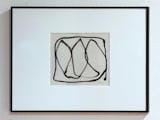My order was given a long lead time, however, the watercolors arrived well ahead of time. I’ve not seen other watercolors to match the quality of these. Overall a great online buying experience.
When used for painting or for seals, this ink has an special liveliness with its orange undertone and is almost identical to true cinnabar red.
It is odorless and fluid, you can use this ink with stamp pads as it has a good shelf life and will not dry out easily.
The ink, however, once on paper will remain smudgeable, even dry. So make sure to use a water-friendly or oil-friendly coating or protection when storing your artworks.
It is very pigmented, a small amount of ink goes a long way.
It got delivered in perfect condition with washi tape securing it closed.
The attached image of the "レア" seal was made using Kobaien’s High Quality Vermillion Red Liquid Ink ( 高級朱墨液・赤 ) with a handmade linoleum stamp.
I am very happy and honored to own this product and will buy it again when my reserve will deplete.
This ink is of amazing quality, the black has profound depth while the grey has a very subtle but elegant purple undertone. It applies smoothly and cleanly while the intensity is easy to control, it is similar in application to handmade watercolor but dries a little slower.
It got delivered in perfect condition.
This artwork I made depicting an Australian Redback spider (Latrodectus hasselti) was made using:
-Gyouun ( For quality works, 暁雲 墨汁 墨液 ) Sumi liquid ink, for the spider color and "森" black seal.
-Kobaien’s High Quality Vermillion Red Liquid Ink ( 高級朱墨液・赤 ) for the spider's pattern and "レア" red seal.
-400g cold pressed watercolor paper.
-Coliro (Finetec) watercolor in shade "Aurum" for the circle.
-SAKURA Pigma Micron fineliner 003 & 03 for details.
I am very happy with this ink and honored to own such fine product.
This ink has a WONDERFUL mystical depth and spiritual quality, whole room is radiating through that.
I ordered one of the Sunshinsenko ink sticks recently and I'm very please with it. It produces rich black ink with very little effort on a good inkstone. I like the ink, it smells wonderful, and it's even attractive to look at. It comes in a wooden box for storage. Recommended. I've included a photo of an abstract piece I did on Green Kitakata paper.




































































